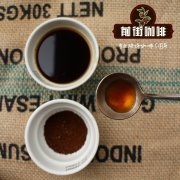Is Africa rich in coffee beans? why are African coffee beans so popular?

Professional coffee knowledge exchange more coffee bean information please follow the coffee workshop (Wechat official account cafe_style)
Of all the coffee-producing countries, Ethiopia is probably the most eye-catching. In addition to the unique and outstanding coffee produced in the country, the mysterious legend of the local coffee adds charm. According to the ancient legend of Egypt, the first coffee tree in the world took root in Lake Tana, with the famous "Coffee Genesis" color murals in the local monastery, as well as the widely spread "Shepherd Kadi and dancing sheep".
Growing coffee, stir-frying coffee and making coffee are the unique cultural heritage of Ethiopia. What is more interesting is that Ethiopian farmers are used to growing cash crops such as coffee and cereals in their fields, storing the dried coffee fruit, which can be used as currency, and also for celebrating ceremonies, usually roasted by the hostess in front of the guests and then boiled. This is already a form of culture.
two。 Geographical advantage
Why does Ethiopian coffee grow so well?
First of all, the terrain is high, the main coffee producing areas are at 1300 to 1800 meters above sea level, cool and foggy, and the western, southwestern, southern and eastern areas have a large temperature difference between day and night, and there is no frost in winter, which is the best environment for Arabica to grow and breed the aroma and taste of citrus, berries and flowers.
Secondly, the rainfall is abundant, the heavy rainy season enters from June to September every year, and the rain decreases to the northeast; there is a small rainy season from March to May every year, which just nourishes the Hara producing area in the east. The annual precipitation is 1000-2000 mm, the average annual temperature is 15-30, and the dry and wet season is obvious, which is very helpful to the aroma and flavor of Arabica, which is not found in other producing countries. And Ethiopia is at the equator, and tropical broad-leaved forests provide the best shade.
There is also a good soil quality, the eastern Hara belongs to the Mesozoic soil layer, composed of sandstone and calcium carbonate; Yejia Xuefei, Sidamo and Kafa forest belong to volcanic soil, which is rich in minerals, which is very suitable for the growth of Arabica. And the most important Ethiopian farmers do not have the money to buy chemical fertilizers, manure and fallen leaves, but to strengthen the vitality of the soil.
Tree species have a strong ability to resist self-healing.
Arabica can get leaf rust when it is infected by Alabica, and coffee fruit disease when it is infected with Coffea subtilis. Outbreaks caused by these two fungi usually cause serious harvest losses. But in Ethiopia, Arabica's viability is unmatched elsewhere. After thousands of years of survival, some have evolved immunity. Some studies have pointed out that on average, one in every 100 to 1,000 coffee trees is found to be resistant; even one in every 10000 plants is doubly resistant to coffee fruit disease and leaf rust.
three。 The course of development
Coffee may have been exported from Ethiopia as early as the first few years of the 17th century, when cafes appeared in Yemen and the Middle East. The Ethiopian coffee boom began to fade with the emergence of coffee cultivation in Yemen, Java and the Americas. At that time, wild coffee trees were actually picked from Kaffa and Buno areas, not coffee plantations.
Ethiopian coffee became popular again in the 19th century, when there were two grades: Harari coffee and Abyssinia coffee. The former is grown around the town of Harrar, while the latter is wild coffee from other areas. So Harrar has a long history.
In the 1950s, a new grading system appeared. The Ethiopian Coffee Commission was established in 1957, which was the era of the expansion of Ethiopian coffee industry system. However, in the 1970s, due to the change of the political system, radical Marxism affected the coffee industry, making Ethiopia return to the era of collecting wild coffee, and famine occurred frequently in the 1980s.
In 1991, after a series of freedom movements, the country began to move towards democracy. Ethiopia entered the international market, and the huge market price fluctuations promoted the rise of common cooperatives.
In 2007, Trabocca, the largest raw bean manufacturer in the Netherlands, launched the "Red Cherry Project" to improve the quality of small-scale farms in pursuit of high-quality Essex beans.
The Ethiopian crop Trading platform (ECX) was established in 2008. After the coffee is delivered to the ECX warehouse, the source of the washed coffee area is indicated by 1: 10, the sun-cured coffee is labeled 11, and it is divided into 1-9 grades according to quality, or UG is used to indicate that it is not graded. This ECX system has played a normative role in making contract finance transparent.
With the development of the times, there are more opportunities to operate outside the ECX system to provide consumers with high-quality coffee.
END
Important Notice :
前街咖啡 FrontStreet Coffee has moved to new addredd:
FrontStreet Coffee Address: 315,Donghua East Road,GuangZhou
Tel:020 38364473
- Prev

Do you know how to deal with the silver skin of coffee? how is the silver skin removed from the roasted coffee?
Professional coffee knowledge exchange more coffee bean information please follow the coffee workshop (Wechat official account cafe_style) Silver skin (Silver Skin/Chaff): inside the parchment there is a thinner film covering the coffee beans. Because the color is glossy and silvery, people used to call it silver skin. This layer of silver will fall off during baking. Usually you find coffee when you grind it.
- Next

Where are the four major coffee beans produced? is the origin of coffee in Africa?
Professional coffee knowledge exchange more coffee bean information please follow coffee workshop (Wechat official account cafe_style) Asia and Oceania China: the coffee planting area of Yunnan Province in China has reached 7800 hectares. at present, the province accounts for 70% of the national area and 83% of the country's output. In addition to Yunnan, coffee is grown in Hainan and Taiwan. Coffee distribution zone: Yunnan
Related
- Beginners will see the "Coffee pull flower" guide!
- What is the difference between ice blog purified milk and ordinary milk coffee?
- Why is the Philippines the largest producer of crops in Liberia?
- For coffee extraction, should the fine powder be retained?
- How does extracted espresso fill pressed powder? How much strength does it take to press the powder?
- How to make jasmine cold extract coffee? Is the jasmine + latte good?
- Will this little toy really make the coffee taste better? How does Lily Drip affect coffee extraction?
- Will the action of slapping the filter cup also affect coffee extraction?
- What's the difference between powder-to-water ratio and powder-to-liquid ratio?
- What is the Ethiopian local species? What does it have to do with Heirloom native species?

